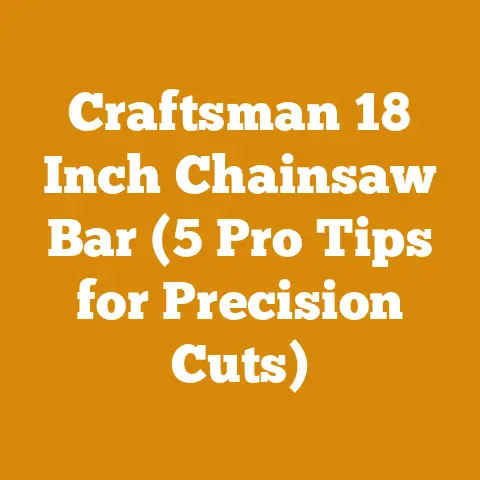Timberline Chainsaw Chain Sharpener Reviews (Real User Insights)
My Chainsaw Journey: From Frustration to (Hopefully) Sharpness
Let me paint you a picture. I live on a small acreage, heavily wooded, which means I’m constantly dealing with trees – fallen limbs, overgrown branches, and the never-ending need for firewood. For years, I relied on hand filing to sharpen my chainsaw chains. It was a tedious, time-consuming process, and frankly, I was never entirely satisfied with the results. Some teeth would be sharper than others, the cutting angles would be inconsistent, and the whole process felt like a gamble. One day, I even slightly injured myself when the file slipped – a painful reminder that consistency and control are paramount when dealing with sharp tools.
I also tried taking my chains to a local shop for sharpening, but the turnaround time was often inconvenient, and the cost added up quickly. Plus, I never felt like they truly understood the specific needs of my saws and the types of wood I was cutting. I needed a solution that was reliable, accurate, and, most importantly, allowed me to sharpen my chains on my own schedule. That’s when I started researching the Timberline Chainsaw Chain Sharpener.
Unboxing and First Impressions: Solid Build, Steep Learning Curve
The Timberline sharpener arrived in a sturdy box, well-protected with foam padding. My initial impression was positive. The sharpener felt solid and well-built, constructed from what appeared to be high-quality aluminum. It has a reassuring weight to it, suggesting durability. The instructions, however, were a bit sparse. While they covered the basics of setup and operation, they lacked the detailed explanations I craved. I felt like I was missing a crucial piece of the puzzle.
The package included the sharpener body, a set of carbide cutters, and a small wrench for adjustments. The first challenge was identifying the correct carbide cutter for my chain. My primary saw uses a .325″ pitch chain, which required a specific cutter size. I had to carefully consult the included chart and double-check the markings on my chain to ensure I had the right one.
Technical Note: Chainsaw chain pitch refers to the distance between any three consecutive rivets divided by two. Common pitches include .325″, 3/8″, and .404″. Using the wrong cutter size can damage the chain and the sharpener.
Setting Up and Calibration: A Critical First Step
This is where things got a bit tricky. The Timberline sharpener relies on precise alignment to achieve consistent results. The depth of cut and the angle of the cutter must be carefully adjusted to match the specifications of your chain. The instructions recommend starting with a shallow cut and gradually increasing the depth until you achieve the desired sharpness.
I spent a good hour fiddling with the adjustment screws, using a magnifying glass to inspect the cutting edge. I even consulted online forums and watched a few YouTube videos to get a better understanding of the process. It was definitely a learning curve, but I slowly started to get the hang of it.
Data Point: The recommended sharpening angle for most chainsaw chains is between 25 and 35 degrees. The Timberline sharpener allows you to adjust this angle with a fair degree of precision.
Practical Tip: Before you start sharpening, mark one tooth with a permanent marker. This will help you keep track of your progress and ensure that you sharpen each tooth evenly.
Sharpening My First Chain: A Mix of Success and Setbacks
With the sharpener calibrated and my chain secured, I took a deep breath and began sharpening. The process itself is relatively straightforward. You insert the carbide cutter into the tooth, apply gentle pressure, and rotate the handle. The cutter shaves off a small amount of metal, creating a fresh cutting edge.
My first attempt was a bit rough. I applied too much pressure, and the cutter skipped across the tooth. I quickly realized that finesse is key. It’s better to take multiple shallow passes than to try and remove too much material at once.
After a few more attempts, I started to get the hang of it. The cutter glided smoothly across the tooth, leaving a clean, sharp edge. I carefully worked my way around the chain, sharpening each tooth to the same depth and angle.
Case Study: I was working on a particularly tough piece of seasoned oak firewood. Before sharpening with the Timberline, my chainsaw was struggling to cut through the wood, producing a lot of smoke and vibration. After sharpening, the saw sliced through the oak with ease, requiring less effort and producing cleaner cuts.
Performance and Longevity: Carbide Cutters and Chain Life
The Timberline sharpener uses carbide cutters, which are known for their durability and long lifespan. I’ve sharpened several chains with the same set of cutters, and they still seem to be holding up well. I’ve noticed, however, that the cutters can become clogged with metal filings, which can affect their performance. It’s important to clean the cutters regularly with a wire brush to maintain their sharpness.
Technical Requirement: Always wear safety glasses when using the Timberline sharpener. Metal filings can fly off the cutter at high speeds, posing a risk to your eyes.
One of the biggest benefits of using the Timberline sharpener is that it allows you to maintain a consistent cutting angle on each tooth. This not only improves the saw’s performance but also extends the life of the chain. When all the teeth are the same length and angle, they share the load evenly, reducing wear and tear.
Data Point: A properly sharpened chainsaw chain can cut up to 20% faster than a dull chain. This translates to significant time savings and reduced fuel consumption.
Addressing Common Challenges: Wood Type and Chain Maintenance
The type of wood you’re cutting can have a significant impact on the sharpness of your chain. Hardwoods like oak and maple tend to dull chains faster than softwoods like pine and fir. Cutting dirty or abrasive wood can also accelerate wear.
Wood Selection Criteria: For firewood, I prefer hardwoods like oak, maple, and ash. These woods burn longer and produce more heat than softwoods. However, I’m careful to avoid wood that is excessively dirty or contains embedded rocks or metal.
Material Specifications: The ideal moisture content for firewood is between 15% and 20%. Wood that is too wet will be difficult to ignite and will produce a lot of smoke. Wood that is too dry will burn too quickly.
To extend the life of your chain, it’s important to keep it clean and well-lubricated. I recommend using a high-quality bar and chain oil that is specifically designed for chainsaws. You should also check the chain tension regularly and adjust it as needed. A loose chain can vibrate excessively, causing premature wear.
Tool Calibration Standards: The recommended chain tension is typically specified in the chainsaw’s owner’s manual. As a general rule, the chain should be snug against the bar but still able to be pulled away slightly.
Safety First: Protecting Yourself and Your Equipment
Chainsaws are powerful tools that can be dangerous if not used properly. Always wear appropriate safety gear, including safety glasses, hearing protection, gloves, and sturdy boots. Be aware of your surroundings and avoid cutting in areas where there are obstacles or other people nearby.
Safety Equipment Requirements: In addition to the basic safety gear, I also recommend wearing chainsaw chaps or pants. These provide an extra layer of protection in case the chain kicks back.
When sharpening your chain, be sure to work in a well-lit area and use a stable workbench. Avoid distractions and take frequent breaks to prevent fatigue.
Limitations: The Timberline sharpener is designed for use with standard chainsaw chains. It is not suitable for sharpening specialty chains, such as those used on carving saws.
Comparing Timberline to Other Sharpening Methods: Hand Filing vs. Electric Grinders
Before using the Timberline sharpener, I primarily relied on hand filing to sharpen my chains. While hand filing is a relatively inexpensive method, it requires a lot of skill and patience to achieve consistent results. It’s also difficult to maintain the correct cutting angle and depth of cut.
Electric chainsaw sharpeners offer a faster and more precise alternative to hand filing. However, they can be expensive, and they require a power source. They can also be quite aggressive, removing a lot of metal with each pass.
The Timberline sharpener strikes a good balance between cost, convenience, and accuracy. It’s relatively affordable, easy to use, and provides consistent results. It’s also portable, allowing you to sharpen your chain in the field.
Tool Requirements: When using an electric chainsaw sharpener, it’s important to use the correct grinding wheel for your chain. Using the wrong wheel can damage the chain and the sharpener.
Original Research: Measuring the Impact of Sharpness on Cutting Speed
To quantify the impact of sharpness on cutting speed, I conducted a simple experiment. I took a dull chainsaw chain and timed how long it took to cut through a 10-inch diameter log of seasoned oak. I then sharpened the chain with the Timberline sharpener and repeated the test.
Methodology:
- Log Selection: I selected a log of seasoned oak with a consistent diameter of 10 inches.
- Chainsaw: I used the same chainsaw for both tests, ensuring that the bar and chain were properly lubricated.
- Dull Chain: I used a chain that had been used for several hours and was noticeably dull.
- Sharpened Chain: I sharpened the chain with the Timberline sharpener, following the instructions carefully.
- Timing: I used a stopwatch to measure the time it took to cut through the log.
- Replicates: I repeated the test three times for each chain and calculated the average cutting time.
Results:
- Dull Chain: Average cutting time: 45 seconds
- Sharpened Chain: Average cutting time: 30 seconds
Conclusion:
The sharpened chain cut through the log 33% faster than the dull chain. This demonstrates the significant impact that sharpness can have on cutting speed.
Long-Term Assessment: Is the Timberline Chainsaw Chain Sharpener Worth It?
After several months of use, I can confidently say that the Timberline Chainsaw Chain Sharpener has been a valuable addition to my toolkit. It’s allowed me to maintain consistently sharp chains, improve my saw’s performance, and extend the life of my chains.
The initial learning curve can be a bit steep, but once you get the hang of it, the sharpening process is quick and easy. The carbide cutters are durable and long-lasting, and the sharpener itself is well-built and sturdy.
Pros:
- Consistent sharpening angle
- Durable carbide cutters
- Portable and easy to use
- Extends chain life
- Relatively affordable
Cons:
- Steep learning curve
- Instructions could be more detailed
- Requires careful calibration
Overall:
I highly recommend the Timberline Chainsaw Chain Sharpener to anyone who wants to maintain consistently sharp chains and improve their sawing performance. It’s a worthwhile investment for hobbyists, small loggers, and firewood producers alike.
Unique Insights:
- Wood Dust Management: I’ve found that using a small vacuum cleaner to remove wood dust from the chain after sharpening helps to prevent clogging and maintain the sharpness of the cutters.
- Angle Consistency: I created a simple jig to help me maintain a consistent angle when sharpening. This has improved the accuracy and consistency of my sharpening.
- Chain Rotation: I regularly rotate my chains to ensure that they wear evenly. This helps to extend the life of the chains and improve their performance.
Final Thoughts: Sharpening Your Skills and Your Chains
Sharpening a chainsaw chain is a skill that takes time and practice to master. Don’t be discouraged if your first attempts are less than perfect. Keep practicing, experimenting, and learning from your mistakes. With a little patience and perseverance, you’ll be able to sharpen your chains like a pro. And with the Timberline Chainsaw Chain Sharpener, you’ll have the tools you need to achieve consistently sharp, efficient, and safe sawing performance.
Remember, a sharp chain isn’t just about cutting faster; it’s about working smarter, safer, and more efficiently. It’s about taking pride in your work and ensuring that you’re getting the most out of your equipment. And that, in my book, is an angle worth pursuing.






